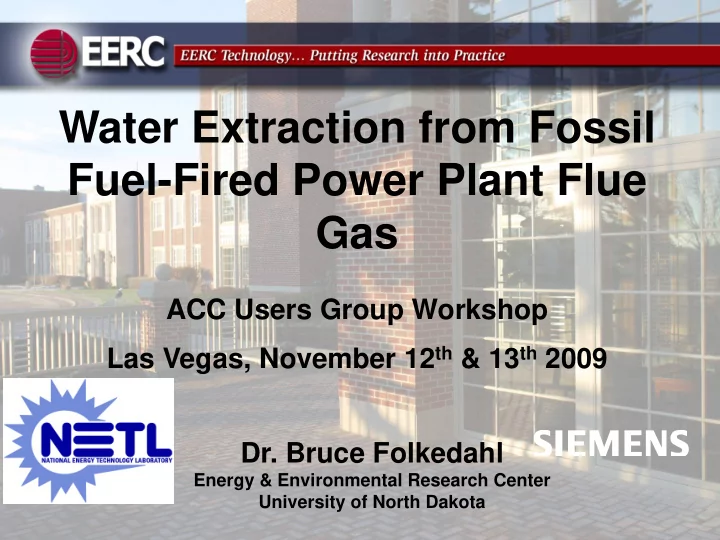

Water Extraction from Fossil Fuel-Fired Power Plant Flue Gas ACC Users Group Workshop Las Vegas, November 12 th & 13 th 2009 Dr. Bruce Folkedahl Energy & Environmental Research Center University of North Dakota
What Does the EERC Do? • The EERC is recognized as one of the world's leading developers of: – Cleaner, more efficient and innovative energy technologies to guarantee clean, reliable energy supplies for the United States and the world. – Environmental technologies to protect and clean our air, water, and soil. • The EERC is a research, development, demonstration, and commercialization center. • The EERC vigorously maintains a nonadvocacy position. • The EERC enhances any guarantee.
EERC Facilities
Providing Strategic Solutions to Real-World Problems The EERC provides practical, cost-effective solutions to today's most critical energy and environmental issues and challenges. Our research portfolio includes: • Alternative fuels • Clean coal technologies – Ethanol, biodiesel, biojet, and • Coalbed methane strategic fuels for the military • Underground coal gasification • Biomass • Emission control • Wind energy – SO x , NO x , air toxics, fine • Water management particulate, and CO 2 • Mercury measurement and control • Flood prevention • CO 2 sequestration • Waste utilization • Global climate change • Contaminant cleanup • Energy and water sustainability • Advanced analytical • Energy-efficient technologies technologies/extraction • Distributed power generation – technologies various fuels • Pesticides and • Hydrogen technologies neurological diseases
“Opportunity is missed by most people because it comes dressed in overalls and looks like work.” –Thomas Edison
Water Permit Denied! Power Project Cancelled Water Is the Next Regulatory Frontier!
Current State-of-the-Art Technology 2700 Typical Water Consumption (2X1 501F Combined Cycle) 300 GPM Water 250 200 190 Even after incorporating an air- 100 cooled condenser with usage 0 optimization, water consumption -100 is approximately 190 gpm (273,000 gallons per day). -200 -300 -400 Wet Optimum Air- Condenser Air- Cooled + Cooling Cooled Condenser tower Condenser Can Water Consumption Be Reduced to Zero? Are There Alternative Sources of Water?
What Can Be Done? Liquid Desiccant Dehumidification System Flue gas water recovery system Desiccant based Power plants can reduce or eliminate water from outside sources Fitted on any power plant that burns carbonaceous or hydrogeneous fuels Retrofit and greenfield applicable
The Liquid Desiccant Dehumidification (LDDS) Process Non- Condensables Air Cooled Condenser Dry Flue Gas Recovered Tank Water Forwarding Pump Absorber Cooler Water Rich Flue Gas Desiccant Water Vapor Treatment Trace Contaminants Weak Regenerator Desiccant Strong Weak Pump Desiccant Strong Pump
Alternative Water Source – Gas-Fired Plants � Across ambient range � Evap. cooling adds more � IGCC plus 25% 2x1 F Class NGCC
Potential Water Available (coal) Water Content of Flue Gas A 700-MW coal plant flue gas may contain approximately 1000–2400 equivalent liquid GPM of water. Varies with coal moisture. Varies with treatment.
Pilot NG Test Results
Proof of Concept Pilot Test Results Summary Pilot Test Results � Complete system with regeneration – demonstrated � Natural gas and coal – demonstrated � System stability – automatic operation demonstrated � Desiccant carryover – undetectable
Water Prices Are Rising Example: Rio Grande Is WETEX ™ Economically Viable? $/acre foot Source: University of New Mexico
Costs of Substitute Technologies Conservative Assumptions Δ Capital Expense Δ Water Cost Total SYSTEM Wet Cooling Tower BASE BASE BASE Dry Cooling Tower $26.6 -$27 -$0.4 Air-Cooled Condenser $14.3 -$27 -$12.7 WETEX with ACC $25.3 -$46 -$20.7 – In millions of dollars – NPV using today’s prices, 3.5% inflation, 10% discount – 25-year plant life – Wet cooling tower cost is $4 million – Wet cooling tower water cost NPV 25 years $46 million – Water cost $0.003/gal for raw water, $0.05/gal for demin. water – WETEX enables $18 million. Savings on demin. water Using Rio Grande prices, the savings from WETEX with ACC would be $127 million.
Commercial Market Vision New Air-Cooled Power Plants Worldwide 200 180 160 Num ber of New Plants 140 120 93 100 80 68 Number of New 60 33 Plants Built with Dry 40 Cooling 18 11 20 0 1980-1984 1985-1989 1990-1994 1995-1999 2000-2004 2004-2009 2010-2014 SIEMENS Market Research
Subscale Demonstration at Power Plant Next Steps? Dried Flue Gas Exits Absorber
Conclusions • 30% water recovery is achievable/50% is feasible. • Potential for gas-, coal-, and syngas-fired plants. • Equipment can be designed and operated to meet variable performance and cost targets. • Water quality is exceptional, similar to R.O. outlet.
Thank You “Whiskey is for drinking, water is for fighting” -Mark Twain Energy & Environmental Research Center World Wide Web: www.undeerc.org E-Mail: bfolkedahl@undeerc.org Telephone No. (701) 777-5243 Fax No. (701) 777-5181 Dr. Bruce Folkedahl Senior Research Manager
Recommend
More recommend